Exhaust Muffler Replacement 6.0 L, 6.6 L, and 8.1 L Engines
Removal Procedure
Caution: In order to avoid being burned, do not service the exhaust system while
it is still hot. Service the system when it is cool.
Caution: Always wear protective goggles and gloves when removing exhaust parts
as falling rust and sharp edges from worn exhaust components could result
in serious personal injury.
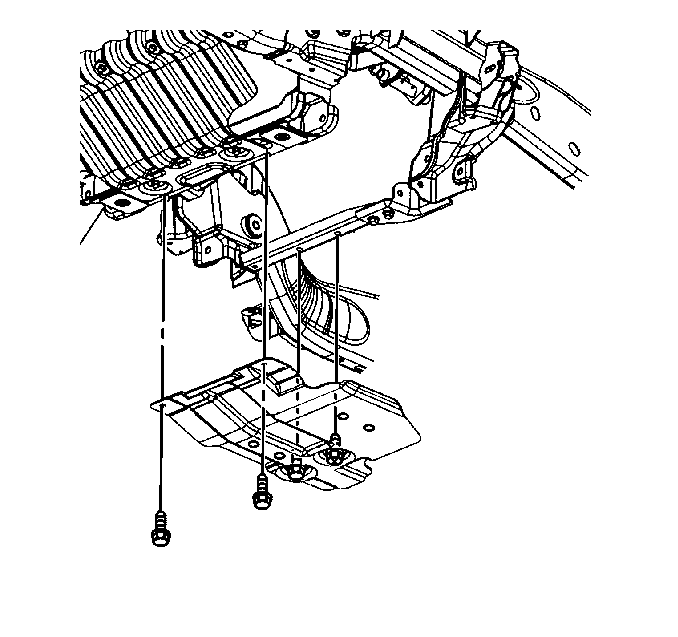
- Remove the rear tires
and wheels. Refer to
Tire and Wheel Removal and Installation
in Tires and
Wheels.
- Remove the oil pan skid plate bolts and plate, if necessary.
- Remove the spare tire.
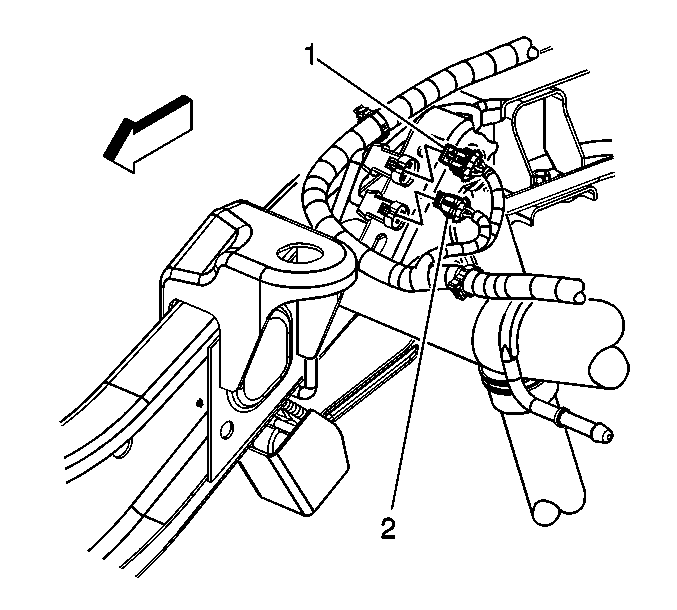
- If servicing a vehicle
equipped with regular production option (RPO) Z55, disconnect the chassis
harness from the following electrical connectors:
| • | Electronic suspension rear position sensor (1) |
Important: Do not attempt the pry the rear suspension sensor link rod from the
rear position sensor ball stud.
- Remove the left and right sensor link rods from the sensors, perform
the following:
| 5.1. | Support the sensor lever with your hand |
| 5.2. | Twist the link rod in order to remove it from the ball stud |
- Install adjustable jack stands under the rear axle.
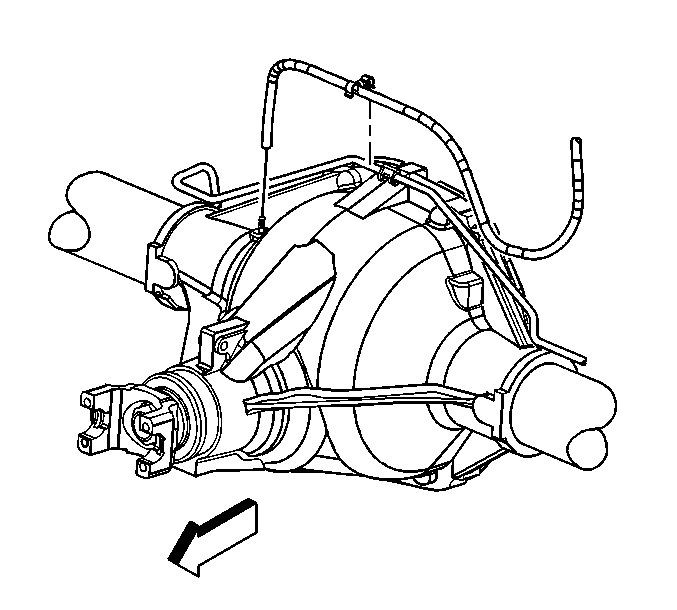
- If equipped with a 8.6
or 9.5 inch ring gear, remove the rear axle vent hose from the rear axle,
if necessary.
- Remove the vent hose swivel clip from the rear brake crossover
pipe.
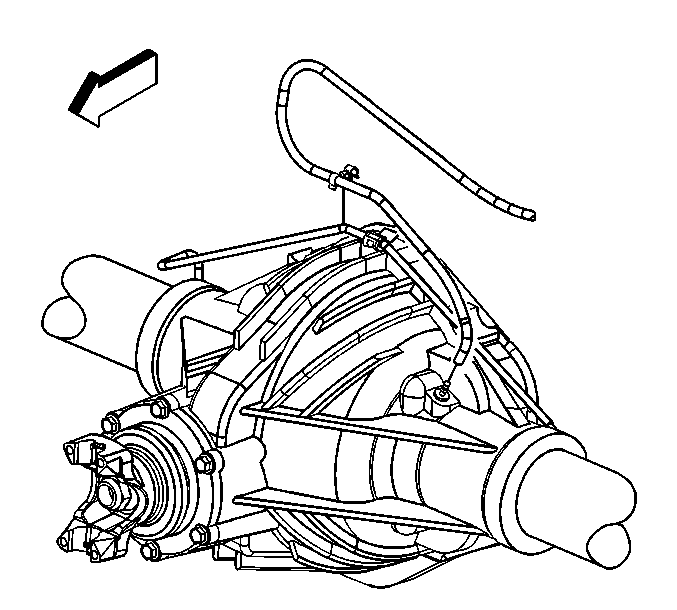
- If equipped with a 10.5
inch ring gear, remove the rear axle vent hose from the rear axle, if necessary.
- Remove the vent hose swivel clip from the rear brake crossover
pipe.
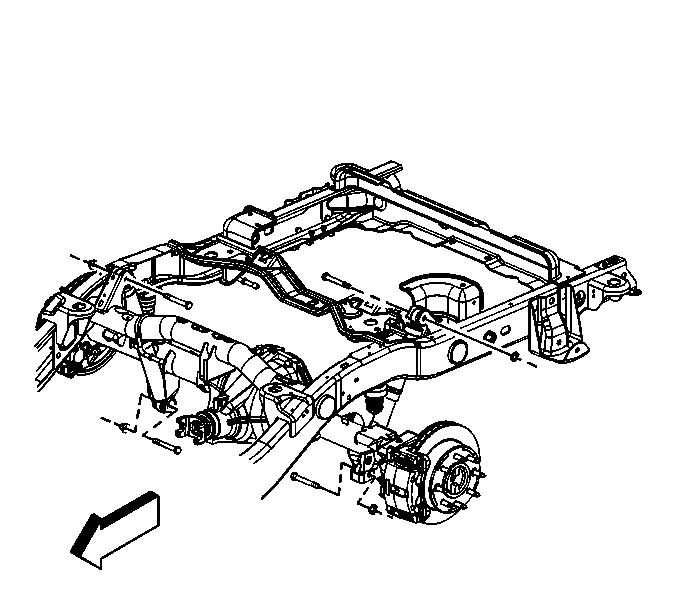
- Remove the rear shock
absorbers lower bolts and nuts.
- Lower the rear axle slightly, using the adjustable jack stands,
in order to remove the muffler.
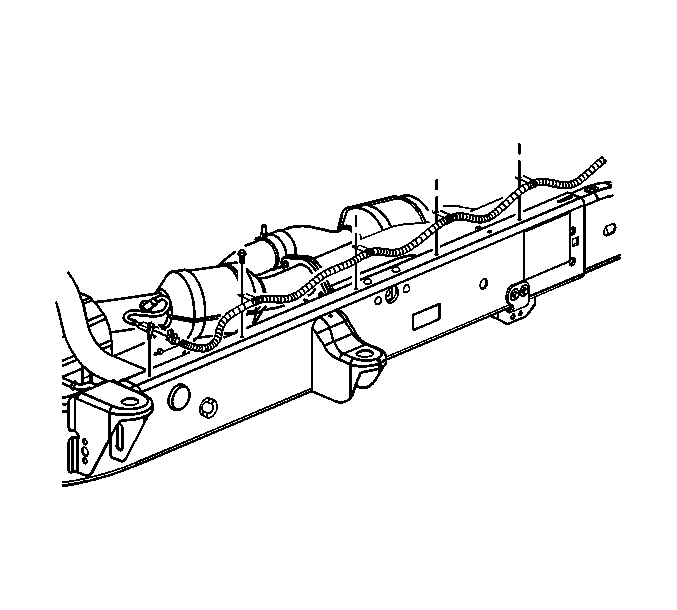
- If equipped with a 6.0L
or 8.1L engine, perform the following:
| • | Unclip the oxygen sensor connector from the frame. |
| • | Disconnect the connector position assurance (CPA) retainer. |
| • | Disconnect the oxygen sensor electrical connector. |
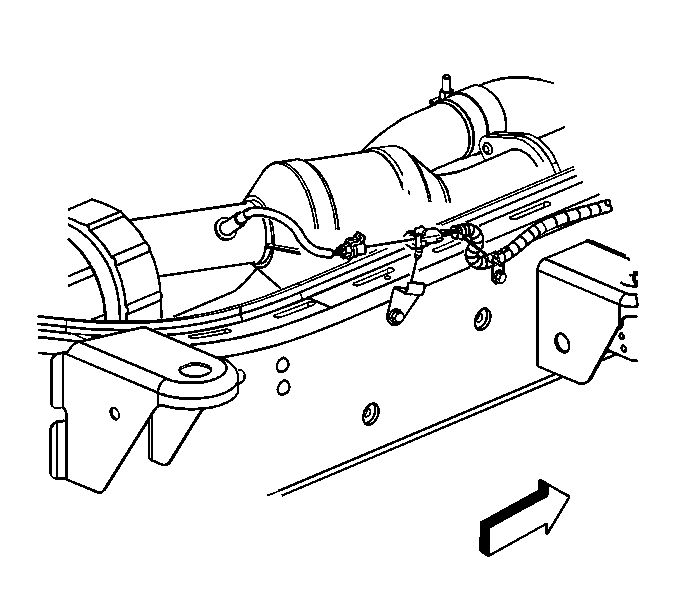
- If equipped with a 6.0L
or 8.1L engine, perform the following:
| • | Unclip the oxygen sensor connector from the support. |
| • | Disconnect the CPA retainer. |
| • | Disconnect the oxygen sensor electrical connector. |
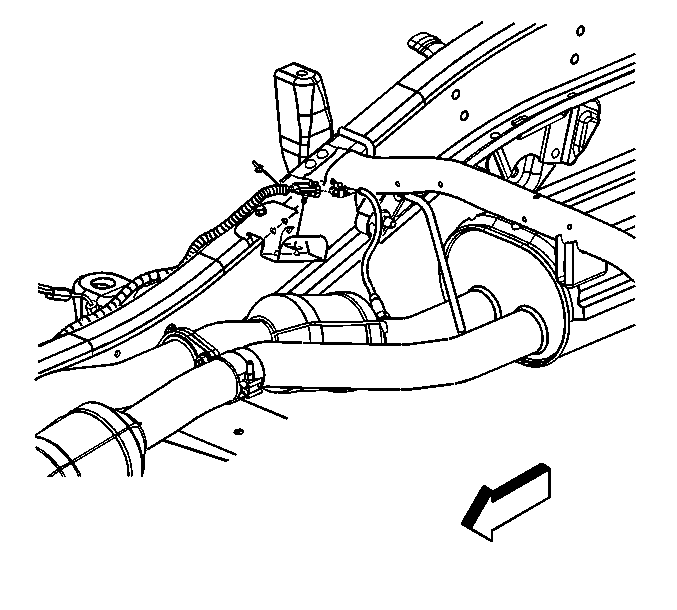
- If equipped with a 6.0L
or 8.1L engine, perform the following:
| • | Unclip the oxygen sensor connector from the support. |
| • | Disconnect the CPA retainer. |
| • | Disconnect the oxygen sensor electrical connector. |

- If equipped with a 6.0L
engine, perform the following:
| • | Unclip the oxygen sensor connector from the frame. |
| • | Disconnect the CPA retainer. |
| • | Disconnect the oxygen sensor electrical connector. |
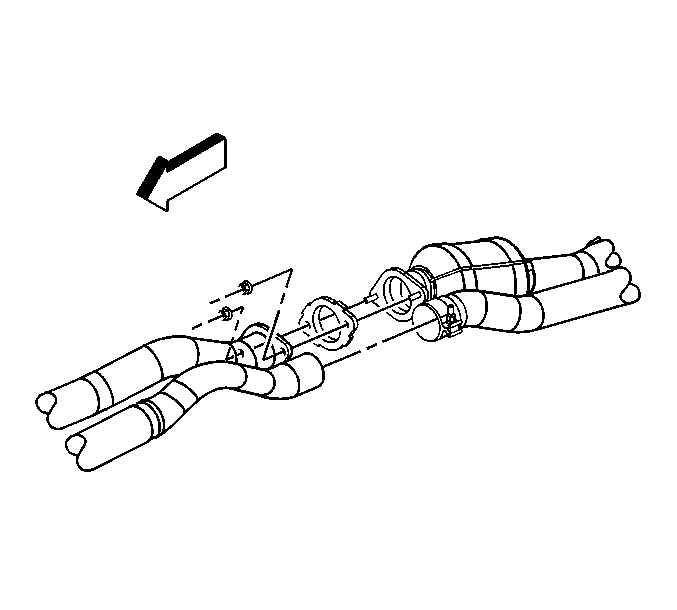
- If equipped with a 6.0L
or 8.1L engine, remove the exhaust muffler nuts.
- Loosen the exhaust pipe clamp.
- With the aid of an assistant, support the exhaust muffler.
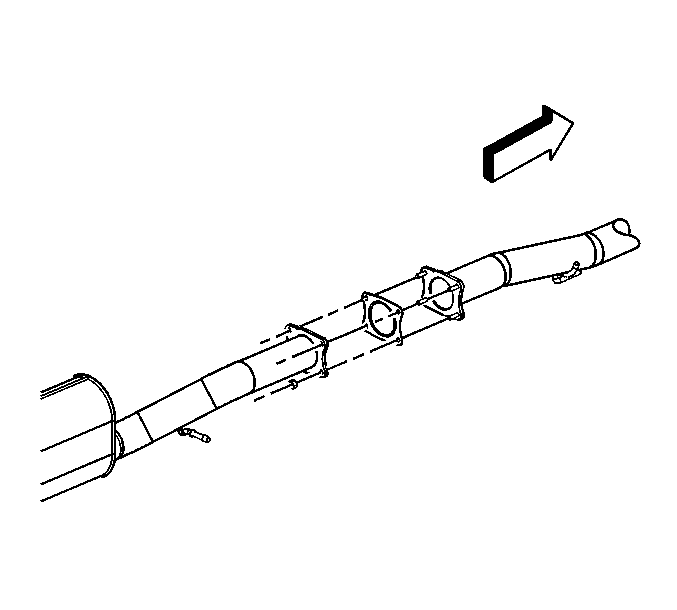
- If equipped with a 6.6L
engine, remove the exhaust muffler nuts.
- With the aid of an assistant, support the exhaust muffler.

- If equipped with a 6.0L
or 8.1L engine, remove the insulators from the frame hangers.
- With the aid of an assistant, slide the muffler rearward in order
to remove the muffler from the catalytic converter.
- Remove the insulators from the muffler hangers.
- Remove the exhaust manifold pipe gasket, if necessary.
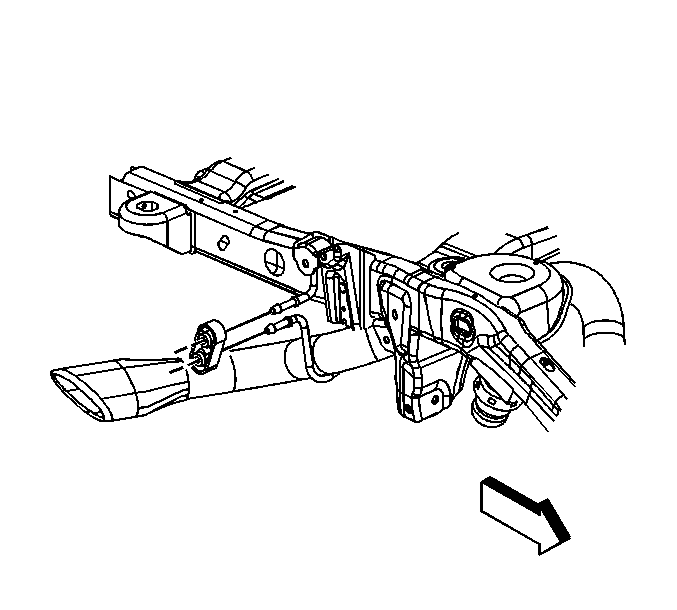
- If equipped with a 6.0L
engine, with RPO Y91, remove the insulator from the frame hanger.
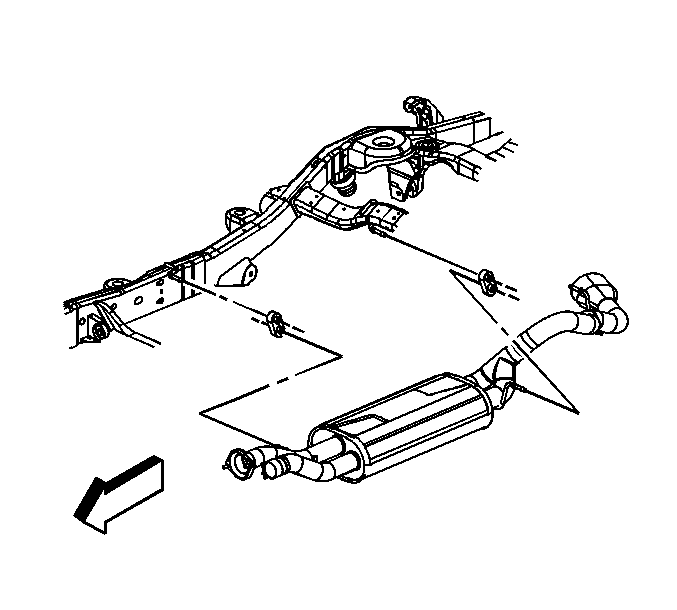
- If equipped with a 6.0L
engine, with RPO Y91, remove the insulators from the frame hangers.
- With the aid of an assistant, slide the muffler rearward in order
to remove the muffler from the catalytic converter.
- Remove the insulators from the muffler hangers.
- Remove the exhaust manifold pipe gasket, if necessary.
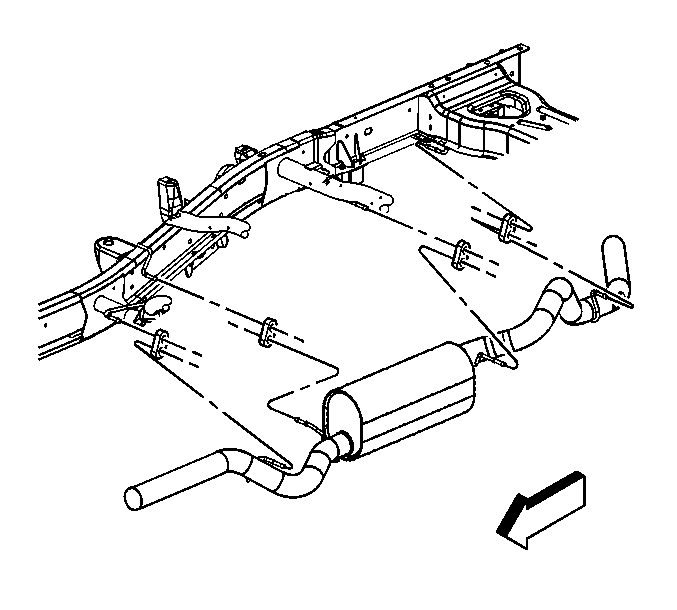
- If equipped with a 6.6L
engine, remove the insulators from the frame hangers.
- With the aid of an assistant, slide the muffler rearward in order
to remove the muffler from the exhaust muffler pipe.
- Remove the exhaust muffler gasket, if necessary.
- Remove the insulators from the muffler hangers.

- If equipped with a 6.0L
or 8.1L engine, remove the oxygen sensor if the muffler is being replaced.
Installation Procedure
Notice: When inspecting or replacing exhaust system components, make sure there
is adequate clearance from all points on the underbody to prevent overheating
of the floor pan and possible damage to the passenger compartment insulation
and trim materials.

- If equipped with a 6.0L
or 8.1L engine, and the muffler was replaced re-install the old oxygen
sensor.
- Apply anti-seize compound GM P/N 12377953 or equivalent
to the threads of the old oxygen sensor.
Notice: Use the correct fastener in the correct location. Replacement fasteners
must be the correct part number for that application. Fasteners requiring
replacement or fasteners requiring the use of thread locking compound or sealant
are identified in the service procedure. Do not use paints, lubricants, or
corrosion inhibitors on fasteners or fastener joint surfaces unless specified.
These coatings affect fastener torque and joint clamping force and may damage
the fastener. Use the correct tightening sequence and specifications when
installing fasteners in order to avoid damage to parts and systems.
- Install the oxygen sensor.
Tighten
Tighten the oxygen sensor to 42 N·m (31 lb ft).

Important: Apply lubricant to the insulators to aid in installation.
- If equipped with a 6.6L engine, install the insulators to the muffler
hangers.
- Install a new exhaust muffler gasket.
- With the aid of an assistant, slide the muffler forward in order
to install the muffler to the exhaust muffler pipe.
- Install the insulators to the frame hangers.

Important: Apply lubricant to the insulators to aid in installation.
- If equipped with a 6.0L engine, with RPO Y91, install the insulators
to the muffler hangers.
- Install a new exhaust muffler gasket.
- With the aid of an assistant, slide the muffler forward in order
to install the muffler to the exhaust muffler pipe.
- Install the insulators to the frame hangers.

- If equipped with a 6.0 L
engine, with RPO Y91, install the insulator to the frame hanger.

Important: Apply lubricant to the insulators to aid in installation.
- If equipped with a 6.0L or 8.1 L engine, install the insulators
to the muffler hangers.
- Install a new exhaust manifold pipe gasket.
- With the aid of an assistant, slide the muffler forward in order
to install the muffler to the catalytic converter.
- Install the insulators to the frame hangers.

- If equipped with a 6.6L
engine, install the exhaust muffler nuts.
Tighten
Tighten the exhaust muffler nuts to 40 N·m (30 lb ft).

- If equipped with a 6.0L
or 8.1L engine, install the exhaust muffler nuts.
- Tighten the exhaust pipe clamp bolt.
Tighten
| • | Tighten the exhaust muffler nuts to 40 N·m (30 lb ft). |
| • | Tighten the exhaust pipe clamp to 40 N·m (30 lb ft). |

- If equipped with a 6.0L
engine, perform the following:
| • | Connect the oxygen sensor electrical connector. |
| • | Connect the CPA retainer. |
| • | Clip the oxygen sensor connector to the frame. |

- If equipped with a 6.0L
or 8.1L engine, perform the following:
| • | Connect the oxygen sensor electrical connector. |
| • | Connect the CPA retainer. |
| • | Clip the oxygen sensor connector to the support. |

- If equipped with a 6.0L
or 8.1L engine, perform the following:
| • | Connect the oxygen sensor electrical connector. |
| • | Connect the CPA retainer. |
| • | Clip the oxygen sensor connector to the support. |

- If equipped with a 6.0L
or 8.1L engine, perform the following:
| • | Connect the oxygen sensor electrical connector. |
| • | Connect the CPA retainer. |
| • | Clip the oxygen sensor connector to the frame. |

- Raise the rear axle, using
the adjustable jack stands.
- Install the lower bolts and nuts to the rear shock absorbers.
Tighten
Tighten the rear shock absorbers lower bolts to 95 N·m
(70 lb ft).
- Remove the adjustable jack stands from under the rear axle.

- If equipped with a 10.5
inch ring gear, install the rear axle vent hose to the rear axle, if necessary.
- Connect the vent hose swivel clip to the rear brake crossover
pipe.

- If equipped with a 8.6
or 9.5 inch ring gear, install the rear axle vent hose to the rear axle, if
necessary.
- Connect the vent hose swivel clip to the rear brake crossover
pipe.

- If servicing a vehicle
equipped with RPO Z55, install the left and right sensor link
rods to the sensors. Using J 38185
install the link rods to the ball studs on the sensor levers.
- Connect the chassis harness to the following electrical connectors:
| • | Electronic suspension rear position sensor (1) |
- Install the spare tire.

- Install the oil pan skid
plate and bolts, if necessary.
Tighten
Tighten the oil pan skid plate bolts to 20 N·m (15 lb ft).
- Install the tires and wheels. Refer to
Tire and Wheel Removal and Installation
in Tires and Wheels.
Exhaust Muffler Replacement 4.3 L, 4.8 L, and 5.3 L Engines
Tools Required
J 38185 Hose Clamp Pliers
Removal Procedure
Caution: In order to avoid being burned, do not service the exhaust system while
it is still hot. Service the system when it is cool.
Caution: Always wear protective goggles and gloves when removing exhaust parts
as falling rust and sharp edges from worn exhaust components could result
in serious personal injury.

- Remove the tires and wheels. Refer to
Tire and Wheel Removal and Installation
in Tires and Wheels.
- Remove the oil pan skid plate, if necessary.
- Remove the spare tire.

- If servicing a vehicle equipped with
regular production option (RPO) Z55, disconnect the chassis harness from the
following electrical connectors:
| • | Electronic suspension rear position sensor (1) |
Important: Do not attempt the pry the rear suspension sensor link rod from the
rear position sensor ball stud.
- Remove the left and right sensor link rods from the sensors, perform
the following:
| 5.1. | Support the sensor lever with your hand |
| 5.2. | Twist the link rod in order to remove it from the ball stud |
- Install adjustable jack stands under the rear axle.

- Remove the rear axle vent hose from the
rear axle, if necessary.
- Remove the vent hose swivel clip from the rear brake crossover
pipe.

- Remove the rear shock absorbers lower
bolts and nuts.
- Lower the rear axle slightly, using the adjustable jack stands,
in order to remove the muffler.
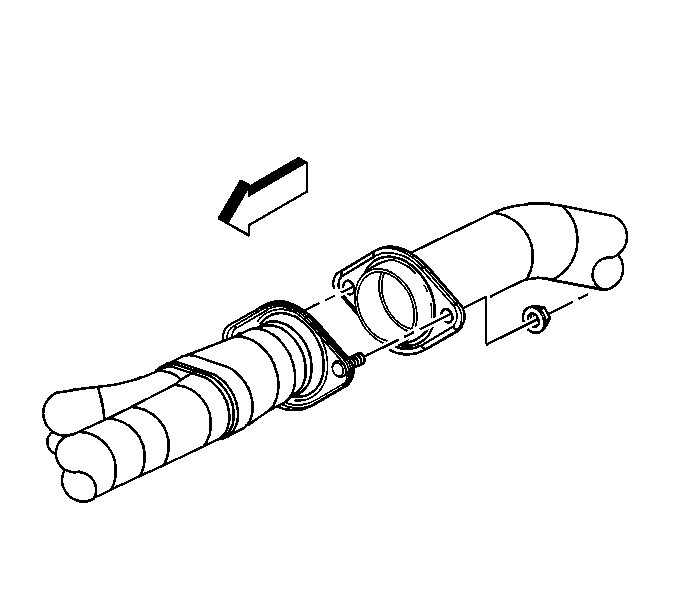
- Remove the exhaust muffler
nuts.

- Remove the muffler from
the insulators.
Installation Procedure
Notice: When inspecting or replacing exhaust system components, make sure there
is adequate clearance from all points on the underbody to prevent overheating
of the floor pan and possible damage to the passenger compartment insulation
and trim materials.

- Apply lubricant to the
exhaust insulators in order to aid in installation.
- Install the muffler to the insulators.

Notice: Use the correct fastener in the correct location. Replacement fasteners
must be the correct part number for that application. Fasteners requiring
replacement or fasteners requiring the use of thread locking compound or sealant
are identified in the service procedure. Do not use paints, lubricants, or
corrosion inhibitors on fasteners or fastener joint surfaces unless specified.
These coatings affect fastener torque and joint clamping force and may damage
the fastener. Use the correct tightening sequence and specifications when
installing fasteners in order to avoid damage to parts and systems.
- Install the exhaust
muffler nuts.
Tighten
Tighten the exhaust muffler nuts to 40 N·m (30 lb ft).

- Raise the rear axle, using the adjustable
jack stands.
- Install the lower bolts and nuts to the shock absorbers.
Tighten
Tighten the rear shock absorber lower bolts to 95 N·m (70 lb ft).
- Remove the adjustable jack stands from under the rear axle.

- Install the vent hose swivel clip to
the rear brake crossover pipe.
- Install the rear axle vent hose to the rear axle, if necessary.

- If servicing a vehicle, equipped with
RPO Z55, install the left and right sensor link rods to the sensors. Using J 38185
install the link rods to the
ball studs on the sensor levers.
- Connect the chassis harness to the following electrical connectors:
| • | electronic suspension rear position sensor (1) |
- Install the spare tire.

- Install the oil pan skid plate and bolts,
if necessary.
Tighten
Tighten the oil pan skid plate bolts to 20 N·m (15 lb ft).
- Install the rear tires and wheels. Refer to
Tire and Wheel Removal and Installation
in Tires and Wheels.












































